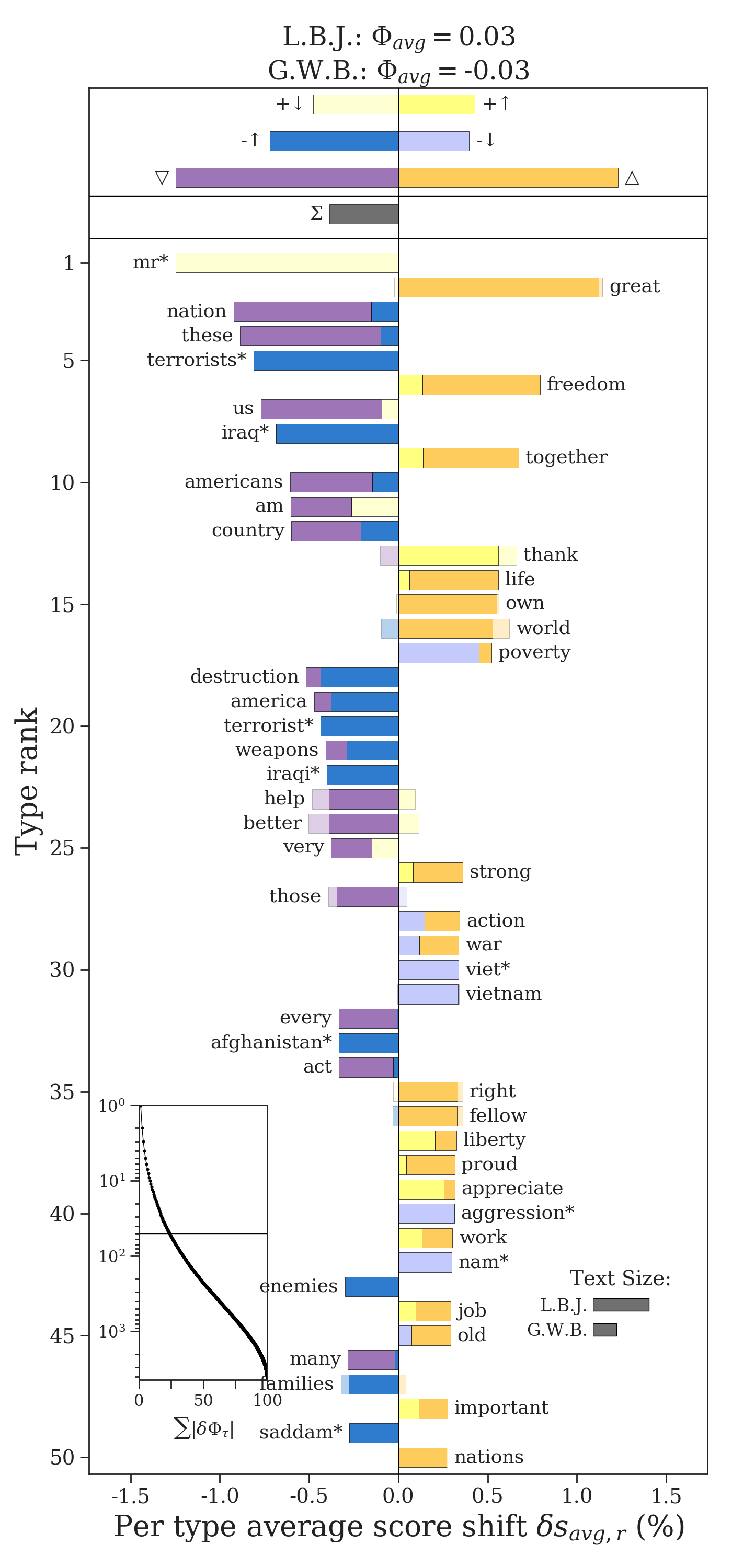以往对比两个文本数据差异,比较简单的技术实现方法是生成两文个词云图,但是词云图无法直观显示词语层面的权重。
Shifterator包提供了构建词移图的功能,垂直条形图可以量化哪些词会导致两个文本之间的成对差异以及它们如何起作用。 通过允许您查看单词使用方式的变化,单词转换可帮助您对情绪、熵和分歧进行分析,这些分析从根本上来说更具可解释性。
Shifterator亮点:
- 提供可解释的工具,用于将文本作为数据处理并映射出两个文本相似性或差异性
- 实现常见的文本比较度量,包括相对频率、香农熵、Tsallis熵、Kullback-Leibler散度和 Jensen-Shannon 散度。
- 基于字典的情绪分析方法计算的加权平均值。
- 在研究初期可用于诊断数据、感知测量误差。
计算社会科学家、数字人文主义者和其他文本分析从业者都可以使用 Shifterator 从文本数据构建可靠、稳健和可解释的故事。
安装
!pip3 install shifterator==0.2.2
导入数据
准备的外卖csv数据,含label和review两个字段。
其中label是好评差评的标注,
- 0为差评,
- 1为好评
import pandas as pd
reviews_df = pd.read_csv("data/WaiMai8k.csv", encoding='utf-8')
reviews_df.head()

有个疑问,外卖好差评中的用词有什么差异(区别/特点)?
准备两组文本数据
shifterator需要两组文本数据,格式为长度相同的词频统计字典。
按照label类别,将数据整理为两个文本数据。在准备的过程中,我们需要做一些清洗操作
- 清除非中文字符,如网址、邮箱、标点符号
- 清除信息量比较低的停用词
import collections
import jieba
import re
texts_neg = reviews_df[reviews_df['label']==0]['review'].tolist()
texts_pos = reviews_df[reviews_df['label']==1]['review'].tolist()
def clean_text(docs):
"""清洗文本中的非中文字符、停用词,返回词频统计结果
docs : 待处理的文档列表
"""
stop_words = open('data/stopwords.txt', encoding='utf-8').read().split('\n')
text = "".join(docs)
text = "".join(re.findall("[\u4e00-\u9fa5]+", text))
words = jieba.lcut(text)
words = [w for w in words if w not in stop_words]
wordfreq_dict = collections.Counter(words)
return wordfreq_dict
clean_texts_neg = clean_text(texts_neg)
clean_texts_pos = clean_text(texts_pos)
无聊的传统绘图
使用条形图、词云图绘制,为了缩小代码量,这里只绘制差评数据。需要注意的是matplotlib不显示中文,这里需要先使用下面三行代码获取电脑中自带的中文字体列表mpl_fonts,
from matplotlib.font_manager import FontManager
mpl_fonts = set(f.name for f in FontManager().ttflist)
print(mpl_fonts)
经过运行,我的电脑mpl_fonts里有Arial Unicode MS ,后面用matplotlib显示中文的地方,我都使用该字体。
#准备DataFrame数据
common_neg = pd.DataFrame(clean_texts_neg.most_common(15),
columns=['words', 'count'])
common_pos = pd.DataFrame(clean_texts_pos.most_common(15),
columns=['words', 'count'])
from matplotlib import pyplot as plt
import seaborn as sns
import matplotlib
sns.set(font_scale=1.5)
sns.set_style("whitegrid")
#为了显示中文
matplotlib.rc("font", family='Arial Unicode MS')
fig, ax = plt.subplots(figsize=(16, 8))
#绘制水平条形图
common_neg.sort_values(by='count').plot.barh(x='words',
y='count',
ax=ax,
color="red")
ax.set_title("外卖差评常见词")
plt.show()

绘制词云图,这里使用的pyecharts包。由于该包作者更新强度比较大,为了保证日后本教程仍可正常运行,这里提供当前我使用的pyecharts相关的版本,大家可以运行下面代码保证运行出正确结果
!pip3 install pyecharts==1.6.2
!pip3 install pyecharts-javascripthon==0.0.6
!pip3 install pyecharts-jupyter-installer==0.0.3
!pip3 install pyecharts-snapshot==0.2.0
import pyecharts.options as opts
from pyecharts.charts import WordCloud
from pyecharts.globals import CurrentConfig, NotebookType
CurrentConfig.NOTEBOOK_TYPE = NotebookType.JUPYTER_NOTEBOOK
wordfreqs = [(w, str(f)) for w,f in dict(clean_texts_neg).items()]
wc = WordCloud()
wc.add(series_name="", data_pair=wordfreqs, word_size_range=[20, 100])
wc.set_global_opts(title_opts=opts.TitleOpts(title="外卖差评词云图",
title_textstyle_opts=opts.TextStyleOpts(font_size=23)),
tooltip_opts=opts.TooltipOpts(is_show=True))
wc.load_javascript()
wc.render_notebook()

使用Shifterator绘制词移图
终于要用到 Shifterator 包了! 我们可以使用这个包根据频率和情绪(或其他值)比较负面和正面的外卖评论,这里我只计算了频率作为权重
熵移图Entropy shift
第一幅图是entropy shift graph
具体信息请查看文档 https://github.com/ryanjgallagher/shifterator
from shifterator import EntropyShift
import matplotlib
matplotlib.rc("font", family='Arial Unicode MS')
entropy_shift = EntropyShift(type2freq_1=clean_texts_neg,
type2freq_2=clean_texts_pos,
base=2)
entropy_shift.get_shift_graph(title='外卖差评 vs 外卖好评')

看起来最能决定外卖差评的用语是配送时间,其次才是口味。
最能决定外卖好评的似乎是口味,其次才是配送时间。
通过Shifterator我们能够看出不同词在不同文本中的作用程度。需要注意的是,我们只使用了最高的前15词频,所以显示的词有些少
总结
希望本文能对你的研究有帮助,代码下载地址
https://github.com/hidadeng/DaDengAndHisPython/tree/master/20211027shifterator学习
代码撰写调试不易,希望帮忙转载


